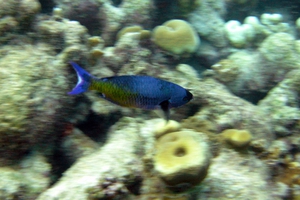Description
Also known as Blue Girl, Creole Reef Wrasse, Purple-tailed Wrasse, Sand-reef Wrasse, Sorrel Chub.
Found singly or in large schools, around shallow reef patches, or midwater feeding, over seaward reef slopes, of coral and rocky reefs. Colour varies.
They feed on invertebrate larvae, small jellyfish, plankton, and pelagic tunicates.
Length - 22cm
Depth - 8-100m
Widespread Western Atlantic, Caribbean
Most reef fish seen by divers during the day, are grazers, they cruise around, just above the surface of the coral, or snoop into crevices, foraging for food.
Wrasses have small protruding teeth, which they use to graze the bottom, taking in a variety of algae, crustaceans, such as crabs, eggs, shrimps, snails and worms. Any hard coats or thick shells, are then ground down by their pharyngeal jaws, and the delicacies inside digested.
From juvenile to adult, wrasses dramatically alter their colour and body shapes.
Wrasses are always on the go during the day, but are the first to go to bed and the last to rise.
Small wrasses dive below the sand to sleep, and larger wrasses wedge themselves in crevices. Ref: https://www.fishbase.se/summary/Clepticus-parrae.html








0 comments